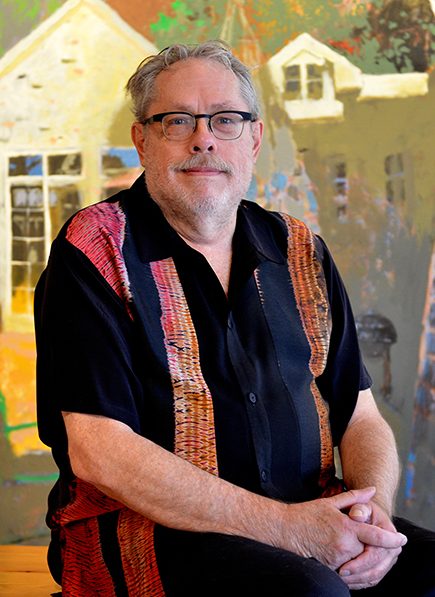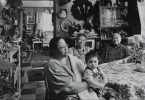Story by Jim Murphy
In the early 1970s, John Cram visited Asheville and says, “I fell in love with the place.” He moved here and found that Asheville was sitting squarely between the mountains and the doldrums.

John Cram. Photo by Paul M. Howey
Beyond the town’s natural attractions, there was not a lot to love. And there was not a lot of demand for a 25-year-old holding a communications degree with a concentration in film. (John calls it “a bachelor’s degree in nothing.”) But just beneath that liberal arts background lurked the soul of an entrepreneur.
“I wanted to open a gallery. I knew I wanted to do it.” But what made him think back then there was a market? “Oh I didn’t think that. I just wanted to do one. And boy, was it a struggle.”
He opened New Morning Gallery in Biltmore Village, and it was doing well enough by 1978 that he was able to borrow the money to buy a much bigger space across the street. It turned out to be just one of several major purchases that have worked out well for John—and very well for Asheville.
He claims he had no clairvoyant vision of a thriving downtown Asheville that was still at least a decade away. One early experience, however, gave him hope. “I noticed the people coming into my gallery, some of them were country people, and they bought handmade objects. They appreciated the objects because they, too, had a history of making things. They got it. They had a connection to it.”
As Asheville began its artistic and economic rebirth, John was instrumental in both aspects of the turnaround. He joined the Tourism Development Board, where he promoted the idea of tourism as a “product” eligible for state reimbursement of a one percent sales tax.
He supported the nonprofit organizations that were dedicated to conservation, a relationship that endures to this day. “I continue to tithe a percentage of sales to give to the Conservation Trust for North Carolina and the Southern Appalachian Highlands Conservancy,” says John.
As an entrepreneur, he found the delicate balance between artistic expression and business success. Just a year after arriving in Asheville, he created the Village Art and Craft Fair, which now brings 120 artists to Biltmore Village every August. And when he expanded his New Morning Gallery, he added a women’s clothing store, featuring creative works in clothing, jewelry, and accessories. He called it Bellagio Art to Wear.
He turned his attention from Biltmore Village in 1990 when he opened the Blue Spiral 1 fine art gallery on Biltmore Avenue. A year later, he bought the Fine Arts Theatre, which had sat empty and decaying.
“It was right next door to Blue Spiral. Some developers wanted to turn it into a nightclub. I bought it, and it took a couple of years before I could afford to have it renovated.” He wasn’t finished though. His next project was to expand on the concept of his Bellagio with a store on Biltmore called Bellagio Everyday.
The new store features creative clothing designs at a lower price point. In two decades, his holdings grew from one small gallery to a movie theater, two clothing stores, and two major art galleries.
Asheville was moving along with him. He recalls the moment he realized something significant was occurring in the city. “By the mid ’90s, things were happening. People were walking around downtown—even on weekdays. One day I was in my office above the Fine Arts with a window looking over Biltmore Avenue. Two ladies were walking down the street, and when a motorcycle went roaring by, I overheard one of them say, ‘That’s a Ducati. They’re built in my hometown (Bologna, Italy).’ I realized at that moment that people were coming here from everywhere.”
Over a 20-year span, John has become a significant presence in the arts scene of a city where the arts are a driving force. He also became an influential figure in the political and conservation arenas. Bottom line is that he participated in—and led—the renaissance of our community.
Recognition was inevitable. John has been honored with numerous awards from local agencies and in 2013, he was given the state’s highest civilian honor, the North Carolina Award for fine arts. Most recently, he was designated a “Downtown Hero” by the Asheville Downtown Association with a citation that reads: “He bet on downtown Asheville long before it was vibrant, thriving, and cool. He and his businesses support the arts, and more importantly the artists.”
Looking back, did the young man with the little gallery ever dream what would become of his endeavors and his city? “Oh, not even close,” says John. “Dreams were never this extensive. It was always one step at a time.” And looking forward, is he content to enjoy his multiple successes or is there another big project in his future? “I do have another big project, but I’m not telling it. I thought I was done, but I came upon another idea…”
Jim Murphy, of East Asheville, is a retired television news reporter and former copy editor for the Los Angeles Times. He can be reached at jimurph41@gmail.com.







[…] By Jim Murphy in The Laurel of Asheville 2016 […]
It’s a sad note to read that John Cram has died. He was such a vital contributor to Asheville. Thank you, John.
John began buying my jewelry in the first year or two that he opened and continued to buy it for the next 50 years. He was a huge help to me in my craft career. John changed Asheville from a craft center to a FINE craft center. I thank him for all he did. I will miss seeing him in the gallery. Dianne Russell